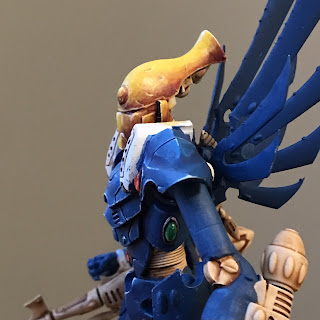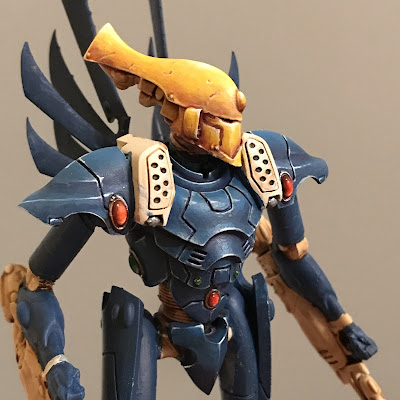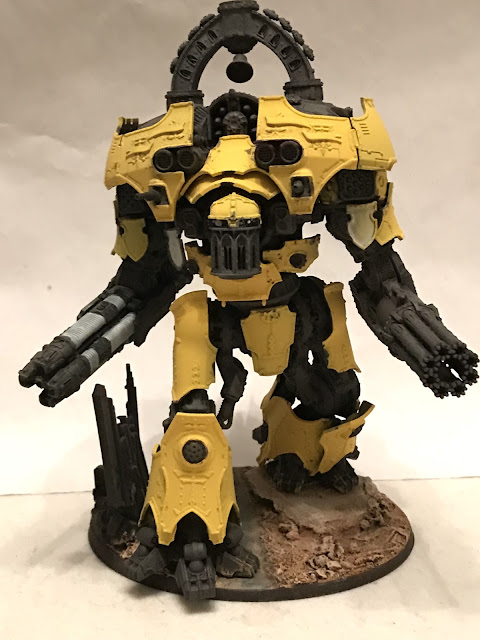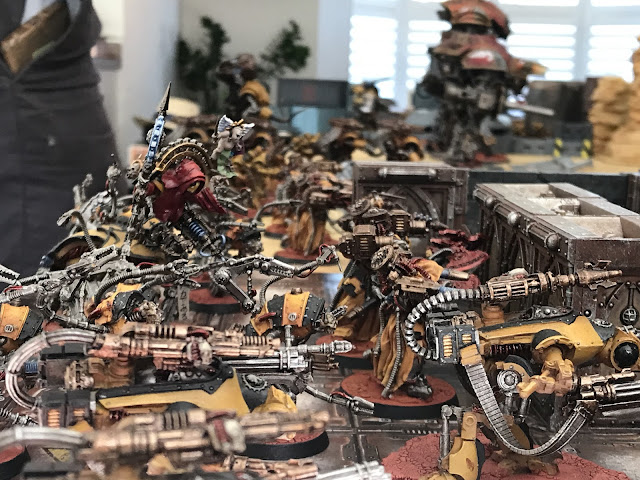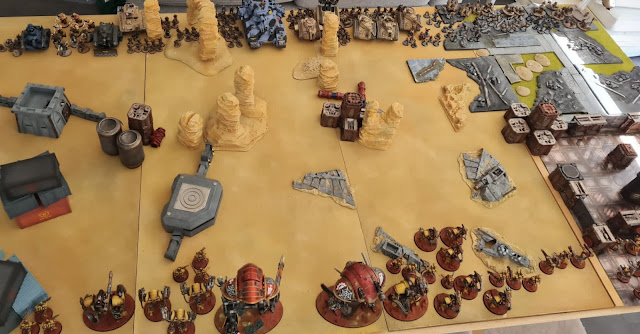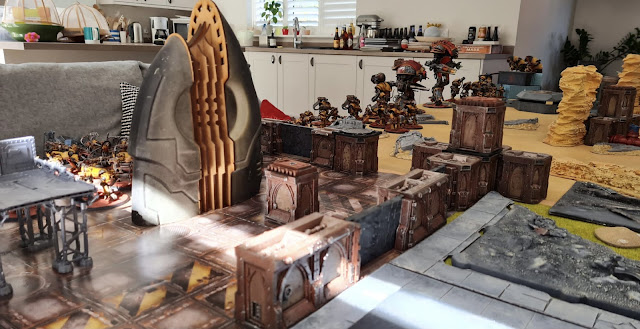+ Catching ghosts+
+ Rules for the Phantom Titan in Adeptus Titanicus +
- To preserve the fun, tension and decision-making of playing the new Adeptus Titanicus
- To allow players to use Eldar Titans that match the background.
- To create a balanced, interesting expansion that enhances the broader game and creates new strategic choices.
+ Where to start? +
The Phantom, or Finnadan, is the most common class of Eldar Titan. As its name suggests, the Phantom is fast moving and very agile, embodying the Eldar military philosophy that prefers speed and mobility to heavy armour. Like all Eldar military vehicles, the Phantom is designed for beauty as much as function, and compared to an Imperial Titan it is very tall, slim and fragile-looking. This appearance is largely deceptive, for the Phantom is strongly built, and can absorb at least as much damage as a human Warlord Titan.
Unlike human Titans, however, Phantoms do not make use of void shields. Instead, they have a system of defensive screens called dathedi (‘between colours’). The screens project a holographic disruption pattern, whose dispersion is linked to the Titan’s movement. Thus, when a Phantom moves, its image seems to explode into a storm of tiny multicoloured shards. The faster it moves, the more scattered its image becomes. When it stops, the cloud appears to coalesce into a solid shape.
Eldar defensive screens are designed to disrupt enemy targeting rather than stop incoming fire as void shields do. Compared to Imperial Titans, the Phantom is vulnerable to damage, but its screens make it more difficult to hit provided it keeps moving. While many Imperial Titan commanders see this as a weakness, it is entirely in harmony with the Eldar conception of war; hit-and-run tactics are normally employed, with the Phantoms using their speed and agility to manoeuvre into an opponent’s blind side before firing.
The Phantom has a crew of four – three living Eldar and one Infinity Circuit. The Infinity Circuit is normally mounted in the centre of the crew compartment in the Titan’s head, and the living crew – frequently blood-relatives of the Infinity Circuit – occupy couches around it. Unlike their Human counterparts, they do not have specific functions. Each crew member is equipped with a headband in which is set a fragment of the carrecenad stone; by means of this they merge their minds with the Infinity Circuit, forming a composite mind capable of handling multiple thoughts and actions. This mind is linked to the Phantom’s mechanical systems by Mind Impulse Units that are far in advance of those used by the Imperium.
The relationship between a Phantom’s living crew and its Infinity Circuit is intimate and all-sharing; they know each other totally, and are marked by their ability to finish each other’s sentences and thoughts out loud. In any other Eldar, this would be unthinkable presumption, but Titan crews are known for the closeness they develop and the eccentricities that arise from it. To Eldar outside the Titan Clans, they are almost a race apart.
- 'the Phantom is fast moving and very agile'
- 'the Phantom is strongly built, and can absorb at least as much damage as a human Warlord Titan'
- 'Compared to Imperial Titans, the Phantom is vulnerable to damage, but its screens make it more difficult to hit provided it keeps moving.'
 |
| + Work in progress + |
+ First steps – getting the Titan to walk +
+ Drafting the Terminal +
+ The basic stats +
- Base size – '[...]fast moving and very agile'. It might be odd to present this quote to defend a smaller base than the Warlord, but base size inherently implies the model will have an easier time seeking cover, avoiding blasts and so forth. For that reason, we'll nudge the Phantom onto a 95 x 120mm base, like the Reaver.
- Scale – Taller but slighter than a Warlord, the Phantom has always been presented as the Eldar's equivalent to the Imperial Warlord. There's an argument for it to be slightly smaller (perhaps scale 9), but for the moment I think it appropriate for it to remain the same scale as a Warlord. 10.
 |
| + Fittingly a greater scale than a Reaver. + |
- Command – I see no great reason that Eldar Titans should be inherently better, so leaving this as-is for the moment seems sensible.: 3+'
- Speed – 'Fast moving...' this is a great opportunity for differentiation. This should be the fastest Battle Titan, but I don't think it should be as fast as a Scout Titan – or it's going to be far too easy for the Phantom to get where it needs to be, and will leave no space for Revenants. My starting suggestion is a base speed of 7in (faster than the Reaver, slower than the Warhound), and a boosted speed of just 9in. This makes pushing less attractive for the Eldar in terms of raw movement, but it might benefit the holofields. A smaller advantage, then, seems sensible. Secondly, these stats tally quite closely with the original Codex Titancius stats.
- Manouevre – '...and very agile' While more manoeuvrable than a Warlord, I think the Phantom should still have the inherent ponderous nature of a giant. I think it would be inappropriate to use (for example) the Agile rules for knights, as it strips out the checks and balances the Imperials need to consider. Nor do I feel a Phantom should be as agile as a Warhound – so perhaps somewhere between Warhound and Reaver is a good spot. As with my reasoning on Speed, having the boosted stat providing less of an advantage seems fitting – Eldar tech is more advanced, but their culture is more risk adverse, so I think the Imperials should benefit more from going hell for leather. Let's test with 3/4.
- Ballistic skill – Doubtless Eldar tech is awesome... but so is Imperial technology. I'd call this a wash and suggest that the BS stays at 3+. Modifiers on weapon cards can alter this if necessary. +
- Weapon skill – I'm tempted to leave this as-is, but taking in the various minor notes from the lore, I wonder if a 4+ (akin to the Reaver) might be nice. I'm picturing a mid-to-short range philosophy for the Eldar, as they'll be encouraged to move, and a higher WS also provides a nice point of differentiation. I suggest 4+ to start with.
- Servitor Clades – We'll need a name change at least, but the underlying mechanics should serve. My feeling is that Eldar Titans should be better at repairing, but we want the Eldar to feel slightly straitened to fit their nature. We also need to bear in mind that we're probably not going to have void shields to reignite or repair, and potentially not a plasma reactor, either, so we need to ensure we don't make repairing the Phantom too easy. After all, quick to damage, quick to repair is a Tyranid thing. Eldar should be tough to damage – it is 'strongly built, and can absorb at least as much damage as a human Warlord Titan' – but struggle to make good the damage. It's harder to regrow wraithbone on the fly than it is to weld a critical plate shut. Let's give the Phantom 3 dice, and we'll have to adjust the Damage Control Phase results; perhaps creating a purely Eldar repair table. +
- Ardex Defensor Cannon – We've given the Phantom quite a lot, and I think this is a good place to take something away. The Eldar are continually noted as being precise with their firepower, so an all-round spray-and-pray defence seems off. Being outnumbered and swarmed by Knights should be a threat to this philosophy of war; the Phantom should have to rely on its mobility for safety, not crude guns like this. Remove this entirely – perhaps using the space on the Terminal for something else.
+ Armour values +
- 'the Phantom is strongly built, and can absorb at least as much damage as a human Warlord Titan'
- 'Compared to Imperial Titans, the Phantom is vulnerable to damage[...]'
+ Shields and plasma reactor +
Holofields
Instead of the energy-absorbing warp-based void fields of the Imperium, or the brute power fields of the Orks, Eldar Titans rely on misdirection, deception and sensor-baffling for defence.
The wing-like harmonic vanes that form a distinctive crest on the backs of Eldar Titans weave a web of photonic projections about the War Engine. The projections create a field of visual distortion, baffling perception across all electromagnetic spectra, and thus making it more difficult for attackers to target the Titan.
While holofields operate dynamically, their effectiveness is enhanced by movement. The faster the Titan moves, the more effective the defence.
- A Unit attacking a Target equipped with Holofields suffers a -2 modifier to the To Hit roll, which is cumulative with other modifiers.
- This is reduced to a -1 modifier if the Target is on First Fire orders or Shutdown orders, or if the Target is Immobilised.
- If the Target has Full Stride or Charge orders, successful to Hit rolls of 6 must also be re-rolled.
- A Unit attacking a Target Unit equipped with Active Holofields may not declare a Targeted Attack.
- Weapons with the Blast trait that Hit a Target Unit with Holofields scatter D6in before the attack is resolved (use the small arrow on the Hit symbol to determine direction). If the attack misses, it scatters D10 as normal.
- Weapons with the Beam trait must make a check against BS with no modifiers when attacking a Target with Active Holofields. If the result is a miss, the Beam continues its path; resolve the attack against subsequent models as though the intervening model was not there.
Holofield: A Special result on the Hit Location Dice indicated the attack has disrupted the vanes of the Phantom's 'wings'. The Holofield flickers out temporarily, and no longer counts as Active for the remainder of the attacking Units' Activation, after which it immediately becomes Active.
+ This means that it's beneficial for an attacker to focus fire on the Phantom, in the hope of getting a lucky hit on the Holofield, which means that its other weapons can fire as normal. +
+ The Holofield can be permanently disabled through damage to the Body (the critical 'Holofield Burnout') result, requiring the ELdar to repair it (see below). +
+ Please note that I've also tried to avoid book-keeping in rules terms. Initially, I played with the idea of the Holofields working better if the model physically moved a number of inches, but this is hard to track and easy to forget in the course of a game. It's for this reason that the benefits to the Holofields relate primarily to Orders. +
+ This also has the nice knock-on effect that Orders become very important to the Eldar – giving a more brittle command style, forcing more thoughtfulness in Command Checks and order of activation, and also signalling to the opposing side what you're going to do. Eldar just aren't as unpredictable as humans!. +
+ The playtest Terminal +
Playtesting Eldar Titans
- List building – Replace all references to 'Maniple' for 'Conclave'. Eldar do not yet have Strategems. I suggest you playtest without them for the moment.
- Game prep – Replace all references to 'Princeps Senioris' with 'High Steersman [name TBC]'. Determine Missions, Deployment and Battle Field Control as normal. Deploy as normal.
- Strategy Phase – Treat all references to 'Infinity Circuit Disturbed' as Princeps wounded'; treat all references to 'Spiritweave Disturbed' as 'MIU Feedback'.
- Movement Phase – Treat all references to 'Reactor' as 'Plasmaweave'
- Damage Control Phase – apply the following adjustments:
- 1. Activate Unit (skip for Knight Households)
- 2. If Reactor Level is orange roll D6; if red, roll D10 on Reactor Overload Table.
- 3. Repair Roll with number of dice equal to 'Shaping'
- 4. Distribute results as follows:
- X+ Repair weapon (see weapon card)
- 4+ Reduce reactor level by 1
- 6 Repair 1 critical damage
- 6 Repair Holofield Burnout [Holofield Burnout: Holofields are inactive]
- Combat Phase – n.b. Weapons on the 'Shoulders' location are not affected by 'Carapace' restrictions.
- To Hit Modifiers – treat references to 'Steersman Wounded' as 'Moderati Wounded'.
- Ignore all reference to Void Shields.
- End Phase – Treat all references to 'Plasmaweave Leak' as 'Reactor Leak'.
- Orders tables changes
- Emergency Repairs: Treat all references to 'Servitor Clades' as 'Shaping'
- Shutdown: Replace text with 'Holofields are no longer Active, can only be activated in Damage Control Phase, make normal repair rolls, reduce Plasmaweave level by 2.
- Reactor Overload Table changes
- Treat all references to Reactor as Plasmaweave.
- 1–2 suffer S9 hit to body, bypass Holofield
- 3–5 Holofield Burnout; if Holofield already burned out, resolve as result 6-8
- 6–8 suffer D3 S9 hits to body, bypass Holofield
- 9–10 Titan destroyed; roll D3+total number of Plasma Track holes in inch for radius, all units suffer D6 hits with Strength = Scale+1, bypassing Void Shields and Holofields.
- Holofields and weapon traits clarifications
- Attacks with the Bypass, Melee, Psi trait(s) are affected by Holofields as described above. Note that this means Melee attacks cannot make Targeted attacks until the Holofields are nor Active.
- Units equipped with Holofields are affected by Concussive weapons as normal if hit.
- Attacks with the Firestorm trait are resolved as normal against Units with Holofields.
- Attacks with the Shieldbane or Voidbreaker trait(s) have no additional effect against a Unit with Holofields.



